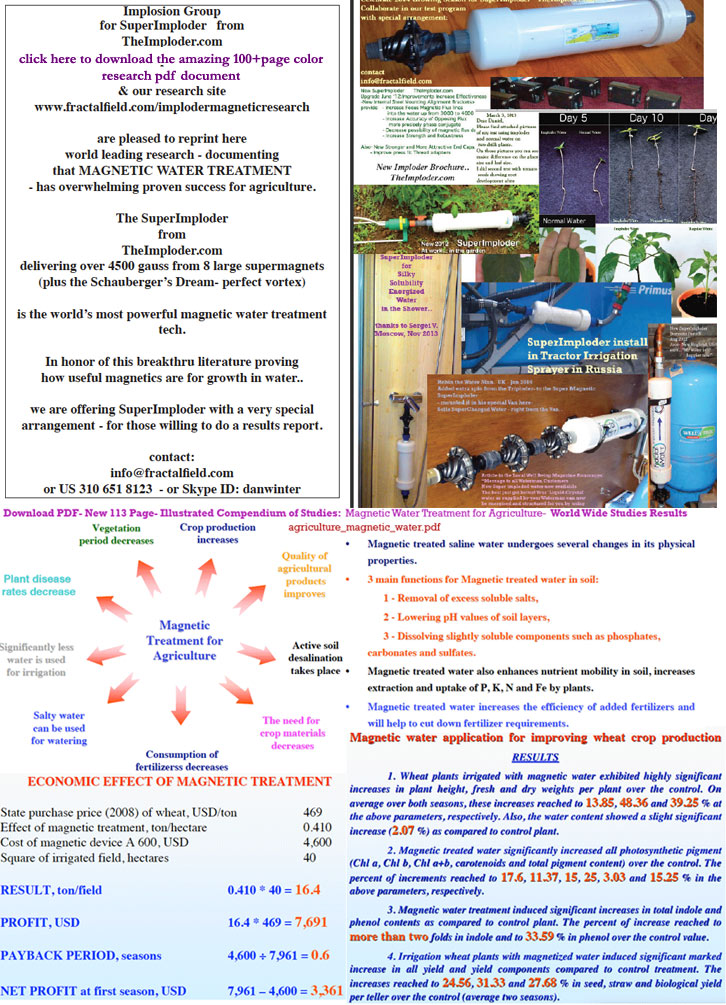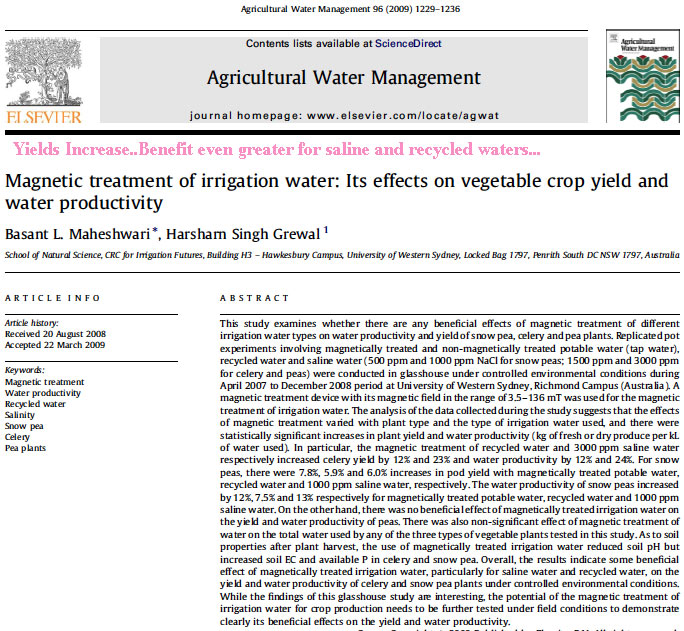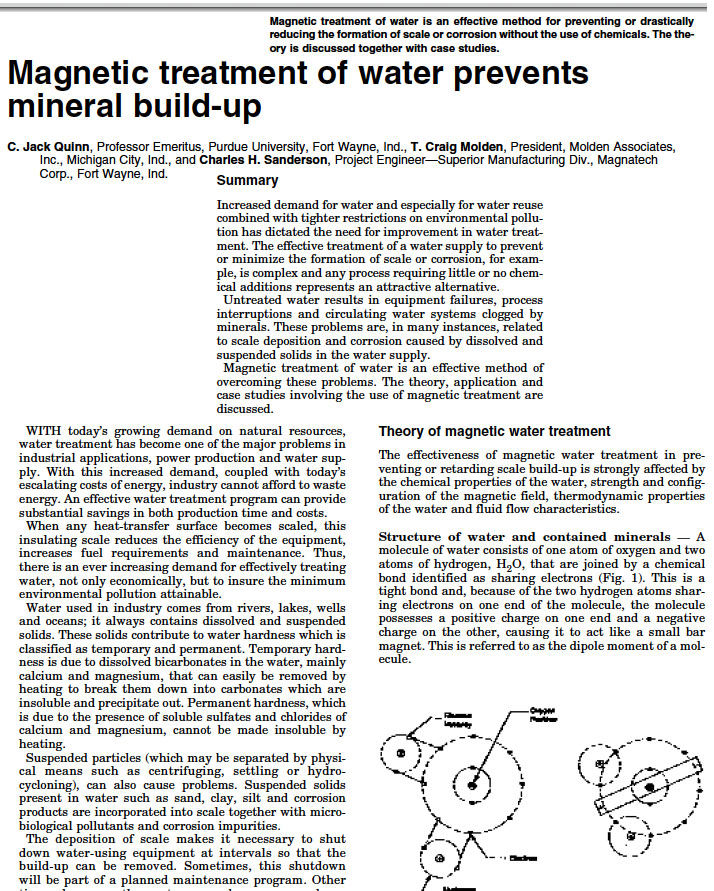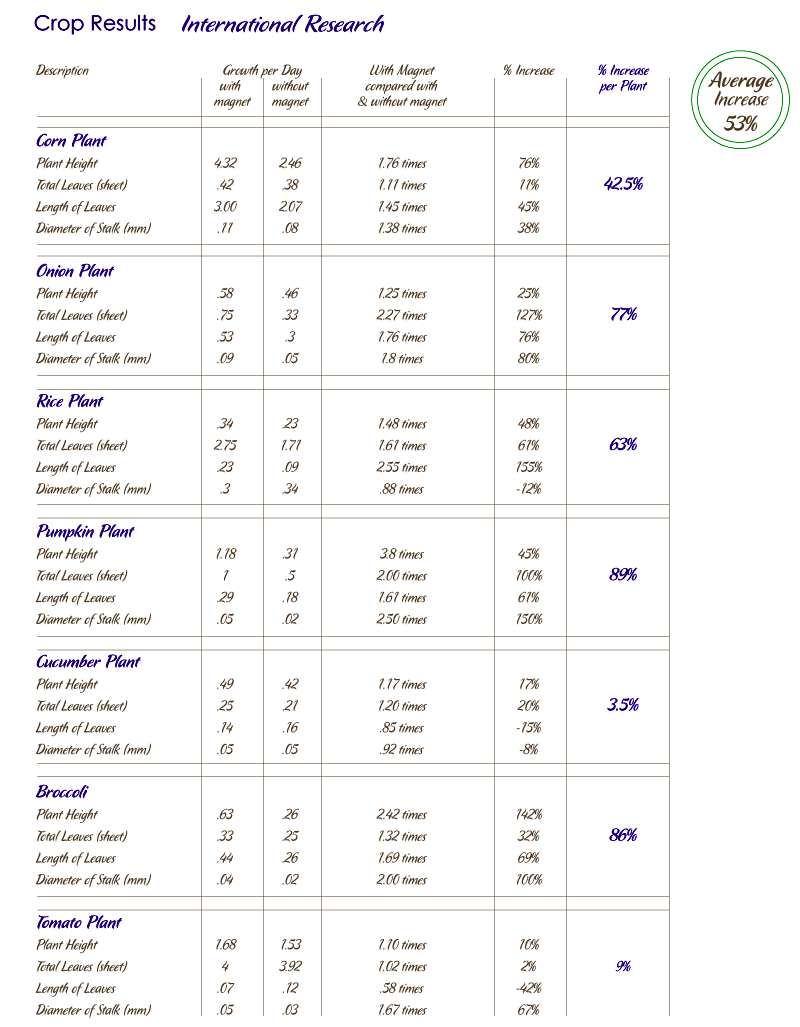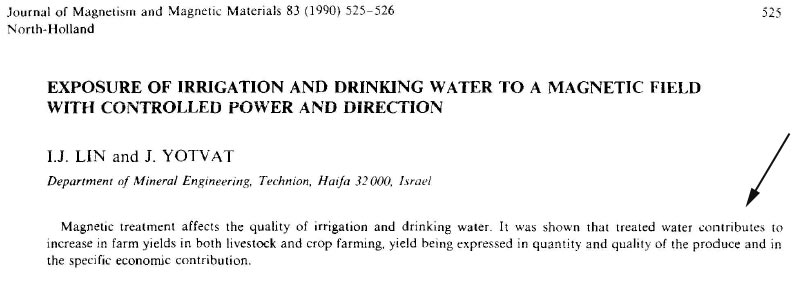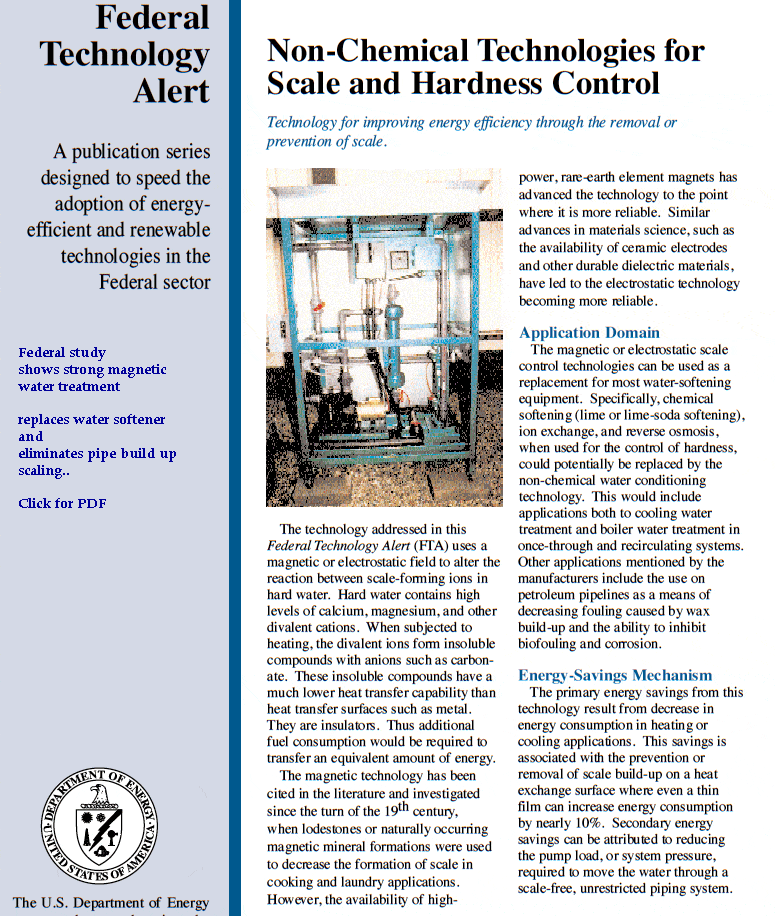Healthy Water Technologies – Magnetized Water
I. Introduction
Magnetic water (MW) is water that has been passed through a magnetic field. Magnetic water treatment devices (MTDs) or magnetic water softeners are environmentally friendly, with low installation costs and no energy requirements. MW can be used to increase crop yield, induce seed germination and benefit the health of livestock. MW treatment is currently used in Australia, Bulgaria, China, England, Japan, Poland, Portugal, Russia, Turkey and the United States for these purposes (Qados and Hozyan, 2010 and Hozayn and Qados, 2010). It is believed that magnetized water used for irrigation can improve water productivity (Duarte Diaz et al., 1997), thus conserving water supplies for the expected future global water scarcity. MW has also been found to be effective at preventing and removing scale deposits in pipes and water containing structures. Magnetized water also can increase the levels of CO2 and H+ in soils comparable to the addition of fertilizers. Cleaning agents have an increased effectiveness when combined with the power of MW, and the amount of cleaner used can be reduced by one-third to one-fourth (Kronenberg, 1993).
II. Principles of Magnetized Water
Natural water contains micro and macroparticles of organic and inorganic natures along with different ions, zoo- and phytoplankton, and microbubbles (Bogatin et al., 1999). Magnetic water treatment is based on the principle of “magnetohydrodynamics”, where; electrical energy is added to charged particles in water that contains ions and small solid particles with electrostatic charges by a magnetic field. The energy is produced by the momentum of the particles and remains attached to the particles as surface energy (Gehr et al., 1995).
Magnetic water treatment works on the principle that as water passes through a magnetic water softener, a Lorentz force is exerted on each ion which is in the opposite direction of each other. The redirection of the particles increases the frequency of collisions between ions of opposite sides, combining to form a mineral precipitate or insoluble compound (Gholizadeh et al., 2008). Calcium carbonate precipitates out of solution as a sludge and can be easily removed from the system since it will not adhere to pipe walls.

Figure 1. Configuration of ionic particles in a magnetic field (Gholizadeh et al., 2008).
The application of a magnetic field to natural water can enhance degassing by 25-30%, caused by local dehydration of surface microbubble films and a decrease in pressure in the center of vortices resulting in an increase in free gas bubbles that can then be released into the open air (Bogatin et al., 1999). This degassing increases permeability in soil, resulting in an increase in irrigation efficiency.
When a magnetic field is applied to water the molecular structure becomes more stable and the ability to form hydrogen bonds is enhanced. Magnetizing water can increase the number of hydrogen bonds by 0.34% (Chang & Weng, 2006). In the same study, the researchers verified results of decreased surface tension and increased viscosity with the application of a magnetic field on water.
Applying a magnetic field to natural water causes a redistribution of flow energy because of a momentum change of charged particles. All the particles and ions are electrically charged such that when magnetic fields are introduced convection and induced currents cause the liquid to spin. This movement then effects changes in gas content and the amount of salt crystallization centers in the water (Sherkliff, 1965). The quick change of the magnetic field in a properly designed magnetic water softener loosens hydrate layers and films in a moving liquid, thus enabling coagulation and coalescence (Bogatin et al., 1999).
McMahon (2009) summarizes that in order for water to be properly treated magnets should have a strength reading of approximately 3000 Gauss, the solution should be passed through the device more than three times, that all piping should be steel, copper or PVC II and the orientation of the magnets should be alternating.
III. Physical Benefits of Magnetized Water
1. Salinity
Magnetic treatment of saline irrigation water can be used as an effective method for soil desalinization. The application of a magnetic field on water decreases the hydration of salt ions and colloids, having a positive effect on salt solubility, accelerated coagulation and salt crystallization (Hilal and Hilal, 2000). Field experiments conducted in Egypt showed that, sandy loam soil pots irrigated with normal highly saline water of an electrical conductivity value of 8.2 mmohs/cm retained salts compared to pots irrigated with magnetized saline water (Hilal and Hilal, 2000). The study showed that MW increased leaching of excess soluble salts, lowered soil alkalinity and dissolved slightly soluble salts (Hilal and Hilal, 2000).
2. pH
Joshi and Kamat (1966) and Busch et al. (1985) have observed pH changes with the application of a magnetic field to water. Parsons et al. (1997) confirmed a decrease in pH in a study using sodium hydroxide to stabilize pH at 8.5 then applying magnetic treatment to the solution. In this study, the magnetically treated water required up to 2.5 times more sodium hydroxide compared to the controls to stabilize pH. pH has been shown to decrease from 9.2 to 8.5 after magnetic treatment in a system with Ca(OH)2 (Ellingsen and Kristiansen, 1979), where the degree of the reduction was dependent on the strength of the magnetic treatment. Busch et al. (1985) showed an initial decrease in pH from 7.0 to 6.5, that was followed by an increase in pH with time from 7.5 – 8.0.

Figure 2. The effect of magnetism on the pH of water (Parsons et al., 1997).
3. Permeability
Water becomes degassed in the process of being magnetized and this degassing increases soil permeability, which creates an increase in irrigation efficiency (Bogatin et al., 1999). In addition to soil permeability, MW water interacts with the structural calcium in cell membranes, making the cells more permeable (Goldsworthy et al., 1999). The reduced surface tension observed in MW results in better infiltration of water and a reduction in water and chemical use. At the Indianapolis 500 Brickyard Crossing Golf Course a MTD has been installed to treat irrigation water. An improvement in the infiltration distribution of water has all but eliminated wet and dry area, reducing 80 hours of weekly hand watering to less than 10 hours a week (Ritchie & Lehnen, 2001). The improvement in uniformity distribution of irrigation water has saved money in labor, hand watering and roping off wet areas, and golf cart damage.
IV. Biological Benefits
1. Crop Yield
Lin and Yotvat (1990) showed an increase in crop yield, size and sugar content of melon grown with magnetized irrigation water in South Africa. Maheshwari and Grewal (2009) reported statistically significant increases in the yield and water productivity of snow peas and celery, but no significant effect on the yield or productivity of peas. Harari and Lin (1989) conducted a study that showed the size of muskmelons, the number of fruits and their sugar content were significantly greater when irrigated with MW. Lentils irrigated with MW showed significant increase growth, the stimulation in growth is thought to be attributed to an effect of MW on the induction of cell metabolism and mitosis (Qados and Hozayn, 2010). Magnetized water has been reported to triple seedling emergence of wheat (Hilal and Hilal, 2000). Reina et al. (2002) reported a significant increase in the rate of water adsorption and an increase in total mass of lettuce when treated with magnetic water.
Chickpea plants irrigated with magnetized water grew taller and heavier than plants irrigated with tap water (Hozayn and Qados, 2010). The authors attribute this stimulation to an increase in photosynthetic pigments, where the magnetic water induces cell metabolism and mitosis meristematic cells in pea, lentil and flax (Belyavskaya, 2001). Additionally, it is believed that new protein bands are formed in plants that are treated with magnetic water, and that these proteins are responsible for increased growth (Hozayn and Qados, 2010). MW has been linked to increases in photosynthetic pigments, endogenous promotors, total phenol and protein biosynthesis in plants (Qados and Hozayn, 2010 and Shabrangi and Majd, 2009).
2. Germination
The application of a magnetic field has been shown to induce seed germination, and increase the percentage of germinated seeds. Carbonell et al. (2000) showed an increase of the germination rate and percentage of rice seeds treated with a magnetic field. Moon and Chung (2000) treated tomato seeds with a magnetic field and found that germination rates were accelerated about 1.1–2.8 times when compared to the control seeds. Pinus tropicalis, a tree species endemic to western Cuba, typically experiences a <50% germination rate, when seeds were treated with MW as part of a 2007 study, germination occurred in 70-81% of seeds (Morejón et al., 2007). Germination of broad bean seeds was found to take place 2-3 days earlier when seeds underwent magnetic treatment (Podleoney et al., 2004). But, all studies have not confirmed this increase; Govoroon et al. (1992) observed no effect of magnetic treatment on the growth of pea, flax, and lentil seeds.
3. Livestock
Dairy cows that drink magnetized water have shown an increase in milk production with the same amount of milk fat as present in cows drinking ordinary water. They also have a longer lactation period with fewer non-productive days and overall health is better (Lin and Yotvat, 1990). Levy et al. (1990) demonstrated that young male cattle watered with MW increased their dry feed intake, while improving their digestion and nitrogen retention. Piglets watered with MW drank twice as much water, and grew 12.5% larger than the control group (Kronenberg, 1993). Chickens watered with MW grew larger, with an increase in the meat to fat ratio, and experienced reduced mortality rates (Gholizadeh et al., 2008). Also, poultry have showed an increase in egg production when watered with MW (Lin and Yotvat, 1990).
4. Health
Globally millions of people drink MW as a “healing’ prophylaxis, despite little evidence to support or debunk the benefits of MW on health. In China the use of magnetic materials is a traditional remedy and is becoming more popular in modern medical science. Drinking MW has been reported to improve bladder problems, stroke recovery, arthritis pain and reduce blood pressure. But no systematic clinical trials have been completed to support or disprove these effects (Grusche et al., 1997). Thought to improve the bodily environment through the introduction of a magnetic field, it is believed that MW can strengthen the immune system, antioxidant activity and decrease blood viscosity, cholesterol and triglycerides (Dayong et al, 1999). Decreasing blood viscosity can keep blood flow rates at normal levels, preventing fats and plaque from accumulating on vessel walls and cell membranes.
Oral irrigation with MW has been shown to greatly reduce supra-gingival calculus and plaque on dental patients (Watt & Rosenfelder, 2005). Those patients using the MW irrigator experienced a 44% reduction in calculus volume on their teeth compared to the control group. In tests on animals, Yue et al. (1983) reported a 70% cure rate in the treatment of urinary stones with MW and over 93.9% for salivary calculus.
IV. Scale Reduction
Magnetic water treatment directly influences the carbonate equilibrium in water, leading to the formation of calcium carbonate (CaCO3) particles in solution that then cannot precipitate on pipe walls and other equipment. Particles are carried downstream in pipe flow and are later removed with filtration. Patented in 1945 (Vermeiren) MW can be used to prevent and remove scale and is currently common global use of MW. Mineralized coatings inside pipes and water containers have been found to reduce with the use of a magnetized water system (Lin and Yotvat, 1990) like the Magnation Scale Reduction System. Barrett and Parsons (1998) attribute scale reduction to the effect of MW on CaCO3 particles by suppressing nucleation and accelerating crystal growth. The mechanics of how magnetic treatment interacts with calcium carbonate in solution is still unknown, and further investigation must be completed.
In Gehr et al. (1995), the precipitation of CaSO4 was investigated and found that magnetic treatment induced precipitation of gypsum crystals (CaSO4 2H2O). But also found that if magnetic treatment were to be an effective treatment for scale prevention it would most likely reduce precipitation on solid surfaces and encourage crystallization. Additionally, Parsons et al. (1997) showed that solution pH is reduced by the introduction of a magnetic field, and that this change in pH directly affects scale growth.
Magnetic water treatment for the prevention of scale is accomplished by passing water through a strong magnet that is installed on or in a feed line. Then when the water is later heated, either in a heat exchanger or a boiler, it has lost its tendency to precipitation scale onto the hot surfaces and the deposits that do form have a looser texture that is easily removed (Herzog et al., 1989). Parsons et al. (1997) showed a 48% reduction in scale using MW, and Busch (1997) recorded a 22% reduction.

Figure 3. Results from Lipusa and Dobersekb, 2007. Picture (C) is a steel pipe with scale from untreated water; (D) is a similar pipe with little scale from magnetically treated water.
Swimming pool water quality can be improved by the addition of a clamp on magnetic device on the circulation system. The magnetic device can prevent and remove scale build up at the water line in the pool and filtration system, and allow for chlorine levels to be reduced by one-half (Kronenberg, 1993). With an efficiency rating of 20-40%, clamp on magnetic treatment devices can remove old scale deposits and prevent the formation of new deposits (Kronenberg, 1993).
The U.S. Department of Energy reported that a thin film (1/32in) of scale in a heat exchange surface can increase energy consumption by 8.5%, and scale of up to 1/8in increases energy consumption by 25% (U.S. DOE, 1998). It was estimated that scale removal in Britain cost £ 1billion/year in the early 1990’s (Smith, 2003). The installation of magnetic treatment devices for water softening equipment for the removal or prevention of scale has been shown to generate significant energy savings, even with the initial capital to invest in the technology.
VI. Conclusions
Magnetic water treatment, like the Scale Reduction System, creates additional collisions of ions that precipitate CaCO3, and it changes the free gas content in water that leads to improved crop yields. These mechanisms create many applications for the use of MW, with the use of MW having the potential to become more commonly used in the irrigation of crops, as drinking water for livestock and to prevent and remove scale buildup in hydrologic infrastructure. With many studies showing increases in crop yields and healthier animals as a direct result of using MW, the science behind magnetic treatment is still poorly understood. There are many scientific journal articles that have reported positive effects of using MW, but reported results often have low reproducibility and inconsistences. It's best for farmers to try the technology on their irrigation system and see the results based on their unique variables.
It is worth noting that as a result of the high-energy reactions that take place when making MW, free radicals, atomic oxygen, peracids, ozone and nitrogen containing compounds are formed (Bogatin et al., 1999 and Colic and Morse, 1999). Regardless, MW treatment is considered to be a green technology with a strong power of transmission. Magnetic treatment technologies can reduce energy consumption, chemical resources, and water usages leading to cost savings and environmental improvements. Devices for creating MW is generally compact, with permanent magnets that are clean and safe technology (Otsuka and Ozeki, 2006). Water productivity can increase with the use of MW water, due to improved infiltration. With greater crop yields when MW is used for irrigation, less total water is used per unit of yield. In arid regions with limited water, MW may become popularized for irrigation water for certain crops and livestock.
